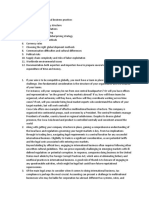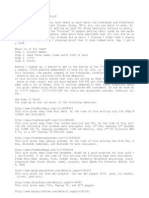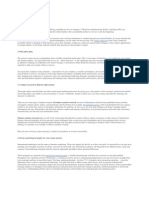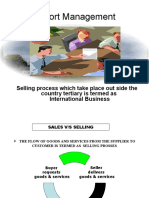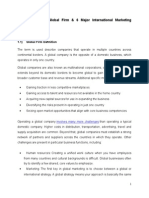Major Tasks Needed To Successfully Organize and Implement An Export
Uploaded by
Viễn PhươngMajor Tasks Needed To Successfully Organize and Implement An Export
Uploaded by
Viễn PhươngMajor tasks needed to successfully organize and implement an export (or import) contract
Exporting can be a great way to grow a company, but it also entails risk. Any entrepreneur looking to expand into foreign markets must first gather information, prepare an export plan, make a series of key decisions and line up the necessary financing.
Gathering information
It's essential for exporters to have a clear understanding of the culture, customs and economic conditions of the country where they want to do business. To that end, research is needed. An online search is a good place to begin. Canada Business provides information on government and private-sector services, markets and industry sectors, and potential partners. It also offers statistics and trade leads. Likewise, the Canadian Trade Commissioner Service provides easy access to hundreds of market studies and country reports, searchable by country or by industry.. Still, nothing takes the place of visiting the target market yourself. On-site, you can talk to potential buyers and learn everything you need to know about the competition, local rules and distribution channels. Attending trade shows and events specific to your industry in that country can also be helpful. While at the shows, take ample notes on products and services, competitors, and packaging and labelling of similar products. For information on upcoming trade conferences and trade shows, try CanadExport and the Department of Foreign Affairs and International Trade Investment Publication. Another way of deepening your understanding of a foreign market is to join business and government delegates representing the Canadian government on a trade missionessentially an organized visit. Because they are government sponsored, trade missions give your company added clout and credibility. It's also worth consulting government sources to define buyers for your products. Trade officers at the International Business Opportunities Centre, for example, collect trade leads globally and match them with Canadian businesses. The World Chambers Network (WCN) offers registered companies opportunities and methods for getting in touch with other interested parties. RFPSource.ca is another business portal providing leads to Canadian businesses.
Preparing an export plan
Before starting up your export operations, be sure you have an export plansimilar to a business plan but focusing instead on strengths, weaknesses, opportunities and threats your company would face in a foreign
market. An export plan should help you define your objectives clearly so that you can use the right tactics to reach your goals, and will give you more credibility with lenders, who will ask you to prove your capacity for exporting. The plan should spell out which countries are you targeting, what opportunities exist there, who your competitors are and how you will market and distribute your products in each location. It should also state whether you will need to adapt your products for the foreign market, how you will determine your export sales price and how much time will be required to meet your objectives. Spell out the staffing levels needed to implement the export initiative, as well as how you will reach your marketthrough distributors or an on-site sales teamand how you will evaluate results to modify your plan when needed. One key issue to be resolved is how you will enter the foreign market. Some of the most common entry strategies involve using distributors or sales representatives, or selling directly to end users. Sales representatives work on commission and use literature and product samples to reach potential buyers, whereas foreign retailers buy directly from your company, relying mainly on travelling sales representatives who contact foreign retailers directly. The third option, direct sales, involves selling your products or services directly to consumers in foreign countries. You may do this online or act on a lead from a government source. Finally, you can use foreign distributors. These merchants purchase goods from an exporter, often at a substantial discount, and resell them for a profit. This can be a cost-effective strategy for small and medium-sized businesses. Not only do you save costs by forming strategic alliances with local people, but you can also rely on their distribution and marketing knowledge.
Make the right strategic choices
Penetrating foreign markets is a long-term commitment that demands a lot of time, effort and money. Your management team must be committed to your efforts and understand the impact that the venture may have on operations. Exporting shouldn't be considered a short-term fix for sluggish domestic sales. Be sure to talk to businesses that have succeeded in your target market. Contact your local economic development agency to find these companies, and consider forming alliances with companies in your sector so as to reduce marketpenetration costs. Don't spread yourself too thin. Successful companies almost always concentrate on one area at a time. Once you've succeeded in your first target market, you can attempt to enter others. You may have to adapt your product, price and promotional campaigns to reflect conditions in the foreign market, including cultural influences (such as religion and traditions), language laws, buyer preferences, engineering standards or product regulations. Your pricing strategy needs to take into account market demand, competition and costs such as tariffs, custom fees, currency fluctuations, value-added taxes (VAT), shipping and insurance.
Finding a foreign partner is much like recruiting a new employee. You want someone who matches your company profile and represents you well. Be specific about the geographical area that you want your partner to cover. Determine if you want an individual or a company to represent you. And generate a list of potential partners or customers who would be most likely to handle your products or services in your target market. An online telephone directory for the country and international associations with foreign representatives may be good places to start. You may also want to consider placing a newspaper advertisement. In some countries, specialized companies can find a suitable representative for you, for a fee. Using an intermediary is especially important if you don't speak the language of the target market. Make sure that you're not competing with your partners and that they have complementary products that may give you a competitive edge. Define your partner's responsibilities, and expect to take a lot of time at the beginning of the process to develop a business relationship. Be sure, too, to specify the commission you're willing to pay and the sales volume you expect your partner to deliver. If there is a contract, ensure that it's governed by Canadian law. Don't offer exclusivity to anybody unless a certain sales level is achieved or objectives are attained. Put everything in writing and be sure you have a reliable way of communicating other than by telephone. Make arrangements with your foreign partner to ensure someone is always available during business hours, even if it is only an emergency resource person. Also, eliminate delays at customs by choosing a good customs broker with whom you are both satisfied.
Lining up financing
Short- and long-term financial planning is crucial to success in any export venture. Rather than dipping into current operating funds, you may need to consider obtaining export working capital, political risk insurance, payment guarantees, security for foreign distributors and clients, and long-term financing to purchase fixed assets.
Financial plan
Lenders prefer sound facts and figures. Back up your information with a strong financial plan, particularly in areas such as export financing. Here you should assess the potential costs of exporting, as well as your expected revenues. You also need to have a clear picture of the amount and type of financing required, both short- and long-term. You should do the following in your financial plan:
Develop an export budget that includes such aspects as product adaptation and redesign costs, consulting fees, marketing costs, travel expenses, distributor commissions, logistics-related costs and all other costs that will affect your bottom line.
Show your financing options.
State how you will handle the costs of expanding, purchasing equipment and streamlining your operations.
Demonstrate how you will collect payment. Assess your cash flow and working capital in the context of longer sales cycles and longer payment terms.
Decide how you'll get paid
Keep in mind that you'll be dealing with clients and intermediaries you hardly know, in an economic context that is foreign to you. Take extra precautions and expect complications with payment. Many payment options are available, including cash in advance, letters of credit, collections and open accounts.
Learn about laws and regulations
Laws and regulations in international trade can be complex, and they may have an impact on various aspects of your export operations. Make sure that any contract you sign stipulates that it is governed by Canadian legislation. You'll also need to investigate how your target market deals with intellectual property, health and environmental standards, taxations, customs and duties, language, consumer protection and payment conditions.
Pay attention to health and environmental issues
More and more countries are adopting strict regulations and standards to protect consumer health and the environment. These apply particularly to food products, prescription drugs, chemicals and common consumer products.
Understand tariffs, customs and free trade zones
When exporting goods into a foreign market you need to clearly understand the various political agreements and arrangements in play. There are four main aspects:
Customs requirements Bilateral customs and trade agreements between another country and Canada Multilateral agreements among trading blocs (examples of blocs include North American Free Trade Agreement signatories, the European Union and South America's MERCOSUR)
Free trade zones
To take advantage of these agreements and arrangements, your company needs to know the conditions they stipulate.Foreign Affairs and International Trade Canada lists the many trade agreements Canada has signed. Tariffs vary greatly depending on your foreign market. Different countries impose different customs and tariffs to protect certain domestic goods from foreign competition.
Know your logistics
Make sure you know exactly how you will ship your product and how you will handle labelling requirements and insurance needs. It's advisable to use a customs broker; trying to understand INCO shipping terms and documentation requirements such as export permits could overwhelm a business. For a fee, custom brokers can help you prepare the necessary paperwork. They can also act as logistics specialists who can help you accelerate the process and handle cross-border shipments. Define your terms of payment, which vary from country to country. Business practices in financial institutions and the currency controls that still exist in many countries can cause lengthy delays in payment. Here are some common pricing strategies:
The most popular pricing approach is the cost-plus method. Your export price is based on your cost of goods plus such costs as tariffs, customs fees, currency fluctuations, value-added taxes, shipping and insurance. The disadvantage of this approach is that you may set prices that are not competitive.
If you're attempting to penetrate a competitive foreign market and gain a certain edge, you could sell or price your product at a lower rate to gain market share.
If your products are high-end luxury goods targeted to specific groups, and if market competition is weak, you may want to sell your products at a higher price than you charge in your domestic market.
If you're entering a Third World market, you could use a flexible pricing strategy, under which your sales price varies globally and is subject to market demand. A development organization such as the Canadian International Development Agency, which helps businesses set up in underdeveloped countries, may also fund a percentage of the cost. These organizations can help you deal with economic and political instability.
You might also like
- Tom Kelleher - Public Relations-Oxford University Press, USA (2020)100% (3)Tom Kelleher - Public Relations-Oxford University Press, USA (2020)465 pages
- The Seven Figure Agency Roadmap How To Build A Million Dollar Digital Marketing Agency (Josh Nelson) (Z-Library)100% (8)The Seven Figure Agency Roadmap How To Build A Million Dollar Digital Marketing Agency (Josh Nelson) (Z-Library)276 pages
- Instant ebooks textbook Marketing. 8th Edition Dhruv Grewal download all chapters75% (4)Instant ebooks textbook Marketing. 8th Edition Dhruv Grewal download all chapters41 pages
- Harrisson A. How To Make Money Online With ChatGPT... 202393% (15)Harrisson A. How To Make Money Online With ChatGPT... 2023194 pages
- 11 Biggest Challenges of International BusinessNo ratings yet11 Biggest Challenges of International Business8 pages
- Strategic Marketing Planning For The Small To Medium-Sized Business93% (28)Strategic Marketing Planning For The Small To Medium-Sized Business30 pages
- Introduction To Exports: Export Procedure (International Business)No ratings yetIntroduction To Exports: Export Procedure (International Business)13 pages
- 12 Step by Step Process To Successful ExportingNo ratings yet12 Step by Step Process To Successful Exporting4 pages
- A Practical Guide To Importing & ExportingNo ratings yetA Practical Guide To Importing & Exporting20 pages
- Details About Issues/Challenges: 1. The Physical DistanceNo ratings yetDetails About Issues/Challenges: 1. The Physical Distance2 pages
- International Marketing: Marketing. "Advances in Communications and Transportation Are Making It Easier To ReachNo ratings yetInternational Marketing: Marketing. "Advances in Communications and Transportation Are Making It Easier To Reach18 pages
- Chapter 2. The Choice of The Target MarketNo ratings yetChapter 2. The Choice of The Target Market5 pages
- How Can Government Improve The Business Climate - The Manzella Report - The Premier Source For Global Business and Economic NewsNo ratings yetHow Can Government Improve The Business Climate - The Manzella Report - The Premier Source For Global Business and Economic News6 pages
- Five Steps Towards International Success by Nerella CampigottoNo ratings yetFive Steps Towards International Success by Nerella Campigotto4 pages
- Preliminaries For Starting Export Business100% (1)Preliminaries For Starting Export Business13 pages
- Methods of Entering Foreign Market Direct ExportingNo ratings yetMethods of Entering Foreign Market Direct Exporting12 pages
- Difference Between Domestic and Global MarketingNo ratings yetDifference Between Domestic and Global Marketing6 pages
- Start The Freelance Business Of Your Dreams: Work From Home And Make The Money You WantFrom EverandStart The Freelance Business Of Your Dreams: Work From Home And Make The Money You WantNo ratings yet
- YOU! A Marketing Consultant!: Learn How To Become A World-Class Marketing ConsultantFrom EverandYOU! A Marketing Consultant!: Learn How To Become A World-Class Marketing ConsultantNo ratings yet
- Immediate download (eBook PDF) M Advertising 3rd Edition by William Arens ebooks 2024100% (7)Immediate download (eBook PDF) M Advertising 3rd Edition by William Arens ebooks 202456 pages
- Digital Marketing: Marketing Results That MatterNo ratings yetDigital Marketing: Marketing Results That Matter1 page
- This Unit Looks at Two Extracts From A Book On The English Law of Contract100% (2)This Unit Looks at Two Extracts From A Book On The English Law of Contract8 pages
- Magnetic Selling - Develop The Charm and Charisma That Attract Customers and Maximize Sales92% (12)Magnetic Selling - Develop The Charm and Charisma That Attract Customers and Maximize Sales257 pages
- 5.0 Mustang & Super Fords - March 2014 USANo ratings yet5.0 Mustang & Super Fords - March 2014 USA132 pages
- Tom Kelleher - Public Relations-Oxford University Press, USA (2020)Tom Kelleher - Public Relations-Oxford University Press, USA (2020)
- The Seven Figure Agency Roadmap How To Build A Million Dollar Digital Marketing Agency (Josh Nelson) (Z-Library)The Seven Figure Agency Roadmap How To Build A Million Dollar Digital Marketing Agency (Josh Nelson) (Z-Library)
- Instant ebooks textbook Marketing. 8th Edition Dhruv Grewal download all chaptersInstant ebooks textbook Marketing. 8th Edition Dhruv Grewal download all chapters
- Harrisson A. How To Make Money Online With ChatGPT... 2023Harrisson A. How To Make Money Online With ChatGPT... 2023
- Strategic Marketing Planning For The Small To Medium-Sized BusinessStrategic Marketing Planning For The Small To Medium-Sized Business
- Introduction To Exports: Export Procedure (International Business)Introduction To Exports: Export Procedure (International Business)
- Details About Issues/Challenges: 1. The Physical DistanceDetails About Issues/Challenges: 1. The Physical Distance
- International Marketing: Marketing. "Advances in Communications and Transportation Are Making It Easier To ReachInternational Marketing: Marketing. "Advances in Communications and Transportation Are Making It Easier To Reach
- How Can Government Improve The Business Climate - The Manzella Report - The Premier Source For Global Business and Economic NewsHow Can Government Improve The Business Climate - The Manzella Report - The Premier Source For Global Business and Economic News
- Five Steps Towards International Success by Nerella CampigottoFive Steps Towards International Success by Nerella Campigotto
- Methods of Entering Foreign Market Direct ExportingMethods of Entering Foreign Market Direct Exporting
- Start The Freelance Business Of Your Dreams: Work From Home And Make The Money You WantFrom EverandStart The Freelance Business Of Your Dreams: Work From Home And Make The Money You Want
- YOU! A Marketing Consultant!: Learn How To Become A World-Class Marketing ConsultantFrom EverandYOU! A Marketing Consultant!: Learn How To Become A World-Class Marketing Consultant
- Immediate download (eBook PDF) M Advertising 3rd Edition by William Arens ebooks 2024Immediate download (eBook PDF) M Advertising 3rd Edition by William Arens ebooks 2024
- This Unit Looks at Two Extracts From A Book On The English Law of ContractThis Unit Looks at Two Extracts From A Book On The English Law of Contract
- Magnetic Selling - Develop The Charm and Charisma That Attract Customers and Maximize SalesMagnetic Selling - Develop The Charm and Charisma That Attract Customers and Maximize Sales



















